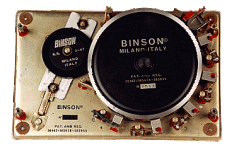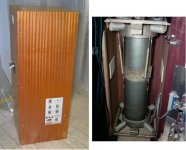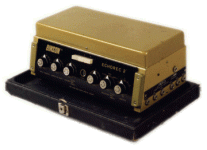Producing echo and reverberation in this form of echo chamber is remarkably simple. A signal from the studio mixing desk — such as a voice or instrument — is fed to a large high-fidelity loudspeaker located at one end of the echo chamber. One or more microphones are placed along the length of the room and these pick up both the sound from the speaker and the echoes of it that bounce off the walls of the chamber. The further away from the speaker, the more echo and reverberation the microphone/s will pick up and the louder the echo becomes in relation to the source. The signal from microphone line is then fed back to the mixing desk, where the echo-enhanced sound can be blended with the original "dry" input.
An excellent example of the creative use of this physical effect can be heard on the 1978 David Bowie song Heroes, from the album of the same name. The song, produced by Tony Visconti, was recorded in the large concert hall in the Hansa recording studio in Berlin and Visconti has since been much praised for the striking sound he achieved on Bowie's vocals. Visconti placed three microphones at intervals along the length of the hall, one very close to Bowie, one halfway down the hall and the third at the far end of the hall. During the recording, Bowie sang each verse progressively louder than the last and as he increased volume in each verse, Visconti opened up each of the three microphones in turn, from closest to farthest. Thus, in the first verse, Bowie's voice sounds close, warm and present; by the end of the song, Visconti has mixed in a large amount of signal from all three microphones, giving Bowie's voice a strikingly reverberant sound.
The original echo chamber at EMI's Abbey Road Studios in London was one of the first in the world to be specially built for recording purposes, when the studio was established in 1931; it remains in place and is a prime example of the early 20th-century electro-acoustic echo chamber.
Buildings such as churches, church halls and ballrooms have often been chosen for the recording of classical and other music because of their rich natural echo and reverberation characteristics. Famous examples include Sir George Martin's AIR Studios at Lyndhurst Hall in Belsize Park, London, a large vaulted 19th century building originally constructed as a church and missionary school. Montreal's Church of St. Eustache is the favoured recording venue of the Montreal Symphony Orchestra and many others, and is much sought after for classical recordings because of its unique acoustic characteristics. Likewise, the distinctive reverberation on the early hit records by Bill Haley & The Comets was created by recording the band under the domed ceiling of Decca's studio in New York, located in a former ballroom called The Pythian Temple.
Some recording companies and many small independent labels could not afford large purpose-built echo chambers such as the Abbey Road chamber, so enterprising producers and engineers often made use of any large reverberant space. Corridors, lift-wells, stairwells, tiled bathrooms and toilets were all used as substitute echo chambers. Many famous soul music and R&B music recordings released by the New York based Atlantic Records feature echo and reverb effects produced by simply placing a speaker and microphone in the office toilet — a tactic also used by The Doors for the recording of their 1970 album LA Woman.
 met een geanodiseerd schijfje die in een beker gevuld met olie ronddraaide, de leeskoppen zijn stukken rubber en het signaal wordt er "statisch" opgezet en afgelezen, de olie dient dan ook als isolator.
met een geanodiseerd schijfje die in een beker gevuld met olie ronddraaide, de leeskoppen zijn stukken rubber en het signaal wordt er "statisch" opgezet en afgelezen, de olie dient dan ook als isolator. met een geanodiseerd schijfje die in een beker gevuld met olie ronddraaide, de leeskoppen zijn stukken rubber en het signaal wordt er "statisch" opgezet en afgelezen, de olie dient dan ook als isolator.
met een geanodiseerd schijfje die in een beker gevuld met olie ronddraaide, de leeskoppen zijn stukken rubber en het signaal wordt er "statisch" opgezet en afgelezen, de olie dient dan ook als isolator.










 , die mogen niet ontbreken natuulk, hier wat plates in voorraad/productie
, die mogen niet ontbreken natuulk, hier wat plates in voorraad/productie 






